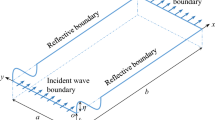Abstract
This paper summarizes a computational procedure for the simulation of wave-structure interactions. The procedure combines the Boundary Element Method (BEM) for potential flows and a predictor-corrector scheme for the time-integration of the nonlinear free-surface condition. In order to have a good representation of a domain of infinite extent, a significant part of the procedure deals with the formulation of a nonreflecting boundary condition for multidirectional waves. This formulation is based on generalizations of modal-superposition in a least-squares sense. In spite of the assumption that the linearized free-surface condition is satisfied in the far field, the proposed nonreflecting boundary condition gives reasonably good performance in absorbing the nonlinear free-surface waves from the interior. The verification and validation of the time–domain computations show very good agreement between the numerical and experimental data from a physical wave basin.
Similar content being viewed by others
Author information
Authors and Affiliations
Corresponding author
Additional information
Financial support for this research, provided by the Offshore Technology Research Center and the Texas Advanced Research Program, is gratefully acknowledged. Computing resources have been made available by the Offshore Technology Research Center and the Department of Civil Engineering at The University of Texas at Austin.
Rights and permissions
About this article
Cite this article
Hardjanto, F., Tassoulas, J. Numerical simulation of the dynamic response of floating structures. Computational Mechanics 32, 347–361 (2003). https://doi.org/10.1007/s00466-003-0492-6
Issue Date:
DOI: https://doi.org/10.1007/s00466-003-0492-6




